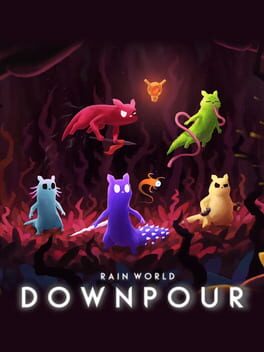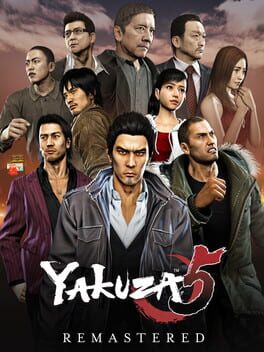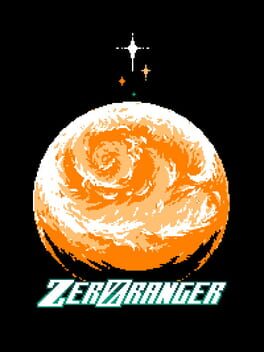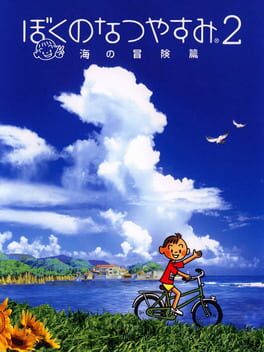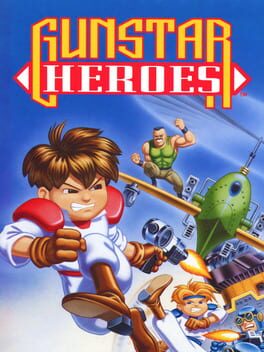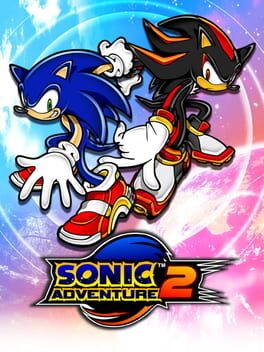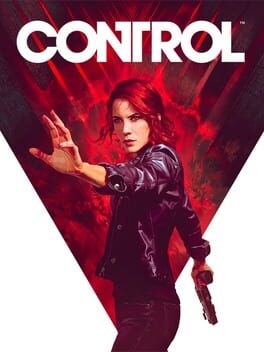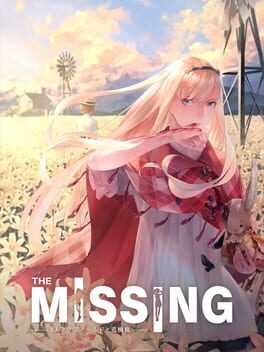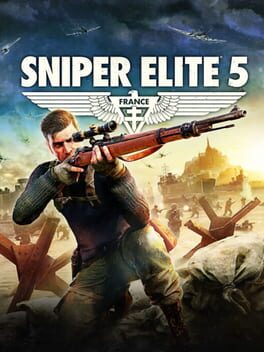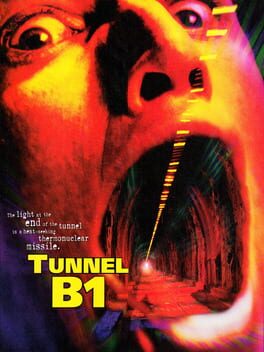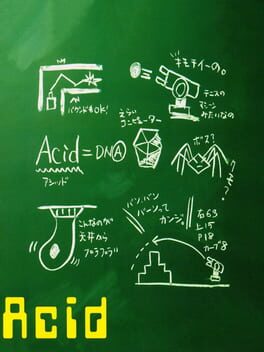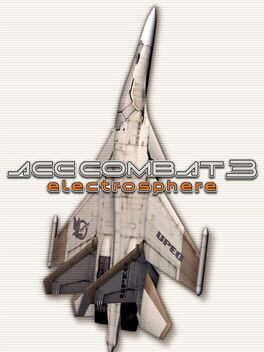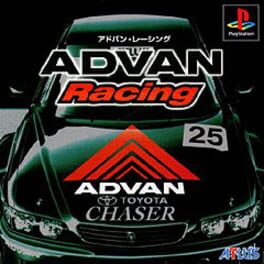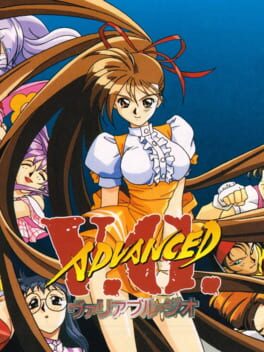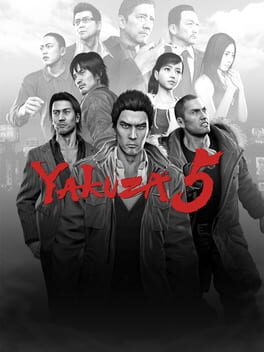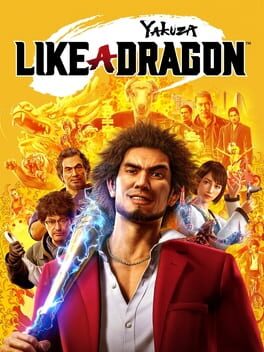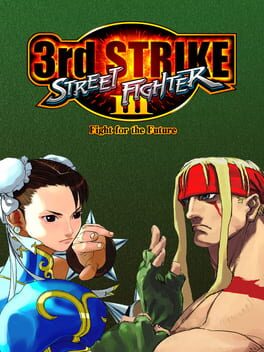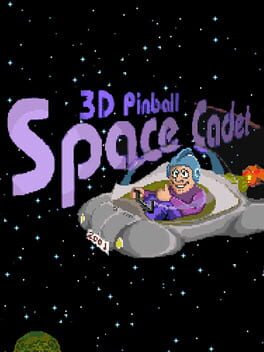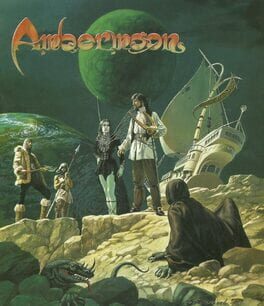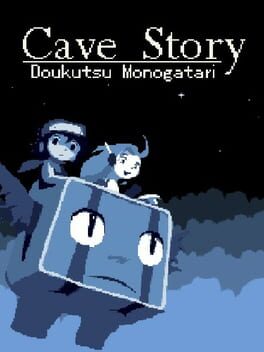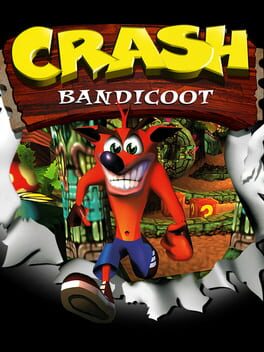359 reviews liked by LukeGirard
Rain World
2017
This review contains spoilers
Imagine you’re a well off kid in the late 80s or early 90s. It’s Christmas, your parents have bought one of those new trinkets called video games, something called a NES (Nintendo Entertainment System), with a pack-in-game cartridge to boot. After waiting for them to get some scissors to cut open the custom cardboard box and set up those incomprehensible cable things (AV cables + AC adapter + RF adapter), you plug the D-pad, pick up the cartridge, blow some air into it (you heard it makes the game run better, it doesn’t), insert it on the slot and press the power button. The screen flares up and you decide to play some game called super mario bros (there's some other game in the menu called duck hunt but who cares?).
Now, assuming you would have never played a game before, nor heard about it, or just waited a couple of seconds in the menu to watch the demo, you’d have no idea of what to do. All you can see is some sort of landscape with a little man-thing in the left corner. So you press the directional buttons and he starts moving, nice. Then you start exploring your surroundings: you try going to the left but there's an invisible wall stopping you, so you go to the right and the screen starts sliding as you go along. That's until some weird brown creature exits from the right corner of the screen, it walks straight to you, but you have no idea what to make of it, so you ignore it. That is, until it touches and kills your little guy, who dramatically falls off from the screen. Two lives left. Damn.
So you start playing again with your newfound knowledge that the little brown thing means bad news. This time you start experimenting with the right side buttons (B & A). You press the left one (B) but it has no apparent effect, so you press the right button (A) and, blam, your little fella jumps. So you advance confidently to where the brown thing is, but instead of walking right into it, you just jump across it. Phew. Now that you can actually advance you see a couple of floating blocks with question marks, curious. You jump on the first block and a coin comes out with no apparent effect, then you go to the next one and a mushroom thing comes out. It trails to the right until falling from the platform’s edge and changing direction by hitting a pipe, coming right towards you. You try to jump but the block above you won’t budge, so the mushroom reaches you and… your guy grows bigger? Nice, so this other mushroom actually helps you, though you have no idea how being bigger does any good besides looking cooler. So you keep advancing to the green pipes: the first one is small enough that a quick button press will get you above it, but the next one is taller and requires a slightly longer press. Ok, so the little guy’s jump height varies depending on how long you press the button. Looking beyond, below the pipe there’s one of the brown guys, but the distance seems just right so you can reach the pipe on the other side by jumping. So you jump while pressing as long as you can, but it isn’t enough and you land exactly atop of the brown guy, ouch. But wait, instead of dying you squash him instantly. Nice! So you can remove enemies by jumping atop of them. So you climb the next pipe and glance to the right and yep, more brown guys, two this time. But you know how to deal with them, right? You jump but this time you slightly misscalculate and land before the enemy. He touches you, but instead of instantly dying, your character gets… smaller? Of course! The mushroom thing makes you bigger, which essentially gives you one more life. But wait, did you forget there were two guys? Why is it that the first guy hurt you while the other passed through harmlessly? You see your character flashing and realize that after being hurt the game gives you a window of opportunity where your character is invulnerable so you can get away from danger. The flashing effect decreases gradually so you can naturally grasp on how much time you have left to reach a safe spot.
Of course, this was a platonic play of mario 1-1. You might as well figure out you can jump from the get-go by experimenting with the buttons. Or ignore the mystery blocks. Or successfully evade the power-up mushroom thinking it’s an enemy. Or never discover you can kill enemies by jumping on them. Either way, what’s important is not that you uncover every basic game mechanic straight away, but that the game allows you to discover new ways to interact with the world without holding your hand. It doesn’t need to show you, but subtly guides you to learn naturally by experimenting with the level design. It set the standard for what good level design ought to be like.
It’s a great experience, tailored specifically to the player. Every block, power-up and enemy is implemented based on how the player will interact with it in a specific way. And the designers can be sure of how you are going to interact with the world: mario can only advance to the right screen (besides pipes and vines), which makes for a mostly linear, manageable experience. As the player gradually familiarizes themselves with the levels, the element of surprise is gone and the experience, though entertaining, turns predictable, which is why even relatively simple AI can learn to master a mario level: it just needs enough attempts to find the best combination of buttons to get across an unchanging obstacle course.
This player-focused design philosophy also affects the game’s mechanics. Mario’s universe is relativistic: everything revolves around the player. Though each level may be loaded with a predetermined code for the entire level, its elements stay inactive until the player comes close enough to interact with them. This can be best exemplified by the spawning (and despawning) of enemies. In super mario bros, enemies spawn in a fixed spot, which is only activated when the player reaches a certain distance from it (which happens slightly offscreen). They may be allowed to exist offscreen as long as they stay close enough to the player character, but the moment they stray too far they disappear entirely. However, since the player can’t progress through the left in super mario bros, this mechanic is usually imperceptible. It’s much more evident in future games, like super mario brothers 2 and super mario world, which allowed players to backtrack and respawn enemies by returning to the left side of the screen. In these cases the games would recognize which direction the player came from and turn the enemies against them, even if most basic mario enemies are unable to automatically turn around to face the player (you could say their life is predestined from the moment they spawn). This is not because the developers did not have the means to stop them from respawning: though enemies always respawn in super mario 2, the map’s items do not, while in super mario world the enemies do not respawn if directly killed by the player since they reward the players with coins once killed (mario 64 would change this by allowing them to respawn without giving rewards beyond the first kill). In some games, like most metroidvanias, this respawning mechanic is crucial to ensure players can replenish health or ammunition dropped by enemies, which usually respawn after re-entering a room. Though the mechanic sacrifices diegetic verisimilitude for gameplay, it feels as if most developers either realized that having enemies spontaneously respawn on-screen would be weird or perhaps unfair. Except for the devs of ninja gaiden, of course, which famously (AVGN is still famous, right?) had the spawn zone set in the corners of the screen (which also meant you could despawn enemies by aggressively outrunning them and letting the corner-of-doom do its job).
One side effect of this is that most mario enemies are basically moving traps. They will completely ignore mario and – unless killed – proceed in their way, until they eventually stumble into a wall, another enemy, fall from a ledge or (more likely) are despawned by going offscreen.
But imagine a different super mario bros, where the player is not the center of the universe. Discard the linear map; have a branching cluster of rooms, with many entries to different worlds, whose acessibility would only be limited by player skill. Imagine if as soon as you loaded up a world it would immediately come alive in its entirety. Where every enemy, from the starting point until bowser’s castle, was constantly existing, even way beyond the reach of the player character’s screen zone. Furthermore, assume every one of these enemies had agency and competed for available resources in the map with themselves. Assume every enemy had a specific identity which the game would keep track of, including their death. Imagine if every one of these enemies had a relationship with your character and could remember how you treated them previously. Sounds utterly insane, right? Contradictory, deranged, self-defeating game design. Only a madman could dream of it. Well, these madmen are called Joar Jakobsson and James Primate; theirs is one of the most amazing games to be released in recent years.
Rain World is one of the few games I “recently” played (what do you mean it has been SIX YEARS!?) which made me think of a “copernican” approach to game design. To turn design postulates and preconceptions on their heads. To be unwilling to compromise originality for a set standard. To challenge what a game ought to be and a player's role in it. Whereas previous platformers/metroidvanias were supposed to be centered on the player as a protagonist, as a means through which the world is experienced, rain world lets its own world take center stage while the player feels like one singular detail in a vast mosaic.
Let’s return to old-schools games. You remember how in these games the existence of npcs depended on the current position of the player character? That even though every spawn point was set, they were only activated as the main character approached them? How enemies would disappear from reality if you stayed away long enough? Well, in Rain World's world (made up of major "regions"), as soon as a region is reached, each of its denizens is spawned and starts acting. The game keeps track of each individual creature, its relationship with other creatures and with the player. You feel as if the world is larger than you, as if it exists independently from you. So that even if you were to be gone it would linger on.
Sounds way too good to be true, right? And in a kind of way it is: one single room in rain world is composed of many objects and particles, besides the creatures which are really moving ragdoll clusters of different body parts with a programmed behavior which is based on their senses. You combine all this with the knowledge that rain world's regions consist of tens of rooms and you start wondering how the game specs do not require a nasa computer.
Like any good magic trick, rain world's is accomplished through a sleight of hand: everything in the current region map exists in two states: abstract and realized. The realized state is the game as you know it: with ragdolls physics, complex path-finding and particle effects. But much like in old-school games, the current position of your character affects how the world around them is rendered. The current room you're in is "realized", as are the neighboring rooms and typically the neighboring room's neighborings rooms (though if you are playing with very low configurations then only your current room is realized). But if you stay too far away the world becomes "abstracted": the possible map paths are simplified and objects are not rendered, though their position is stored. For abstract creatures, the body is not rendered anymore, the pathfinding and AI is simplified, as are interactions between npcs which, instead of being the result of complex ai choices in a dynamic environment with physic effects, are instead based on probability. [1]
So I guess it was all a lie, smokes and mirrors right? Let's not get too carried away: though creatures are abstracted, they are still existing entities: they migrate, do things and interact. Their current agenda is still simulated, even if in a very simplified way: if a wounded lizard starts retreating to its den and has to cross abstract space to do so, it (probably) keeps its current objective and the game simulates the action (probably, because though abstract AI is similar to realized AI, its parameters differ slightly, which may alter creature behavior). All of which is different from an old-school game, where other entities just stop existing altogether if you're far away from them.
One result of the fact that creatures are constantly moving behind your back is that rain world's "deck" is always being reshuffled. A rain world region is similar to an old-school map in that both have predetermined spawn points for npcs spread across them. But whereas old-school entities are only doing things for brief moments of on-screen existence after spawning, rain world's critters are constantly migrating ever since you enter a region. This gives rain world an uncertainty factor; even a veteran player who knows the map like the back of their hand does not know the current locations of creatures or which of them are alive. The fact that the next rooms are “realized” with all the complex actors and effects playing out means you always feel like you’re approaching a situation in media res, as an independent space with independent actors already set in motion. This forces the player to play more cautiously as the world always feels greater than them and beyond their control.
I mentioned creatures spawn and respawn in rain world, but how does that differ from a typical slide scroller? We already know the “region” the player is currently in is simulated, even if mostly in “abstract” state, so the critters start moving as soon as you enter. The starting point from where they move from is a den, the creature’s lair, where it retreats to if it retrieves food, is injured or if raindrops start trickling down. These dens are set in specific spots of the map (except for certain creatures like vultures, which have an abstract unreachable lair), which spawn or respawn creatures. Now, rain world is not a true ecosystem simulator like Species or Bibites, so creatures don’t have a real life cycle, reproduction and the possibility of going extinct. What happens is if a den is vacant, each game cycle will have a chance of spawning a critter in it (which is meant to represent the critter finding this lair and inhabiting it). Depending on the den stats, the next possible critter may be the same subpescies of creature or a different one. If the spawned creature belongs to a different subspecies then there’s a slight chance that the same process happens again with different creature types. Most often this means in-game dens go through different kinds of lizards/centipedes/vultures in what is referred to as the “lineage system”. One of the consequences of this is that if the player kills too many normal enemies, they may trigger the spawn of tougher kinds of enemies through the lineage system.
Another thing rain world is famous for is its critters. In a typical pixel art game you have a cluster of pixels making up a shape, a “sprite”, which are attached to hit/hurt-boxes. These pixel sprites are set to change position and swap to different sprites to give the illusion of doing a continuous action, like walking or jumping. Rain World looks like a typical pixel art game, but its entities are less like mario pixel sprites and more like Gmod ragdolls. Creatures have bodies made of different parts with physical characteristics like length and weight. If a creature wants to get somewhere, it needs to move these parts to get there. Since “animation” is procedural, all sorts of unexpected things may happen naturally: a creature may get stuck, trip over or accidentally fall from a ledge. All of which gives the impression of a real being struggling to use its body instead of an automatic slide scroll.
What sets all these body parts in motion is the AI. First off, AI perceives the game world through its senses: eyesight and hearing (depending on the creature). Eyesight works like a cone-shaped ray that the creature projects from certain spots of their bodies (lizards only see wherever their head is pointed, whereas centipedes are able to see on both ends of their body). The length and accuracy depends on creature type, the environment around, the specific spot of their vision and the regarded object type. Generally the eyesight is better on the center of view while being worse in the periphery (which means every frame you’re in the eyesight radius, there’s a lower percentage chance of being perceived in the periphery compared to the center). Its radius is limited by the environment type: aquatic creatures can see well in the water whereas terrestrial ones have their line of sight broken by it. Another factor is the regarded object: moving around as the player makes you easier to notice, whereas crouching gives a lower chance of being perceived.
Once a creature perceives something it has to identify it: should I ignore it, eat it or run away from it? Also, how many other things are in the room with me? Are they a threat in some way? Are they a resource? Yet, the creature's intent must be comprehensible and clearly communicated to the player. This is what Joar defined as "trickability"; the AI needs to have a complex enough set of faculties to appear "dumb", to be foolable:
"Trickability - This is the thing - the problem that needs to be solved. The idea is that you want the AI to be smart enough so that the player can trick it and get satisfaction out of having outsmarted it. When it comes to Rain World AI, this is the holy grail I'm pursuing. Every amount of complexity on the AI's part should generally fall back on this; this is why the AI is complex. An NPC that just moves towards a target on visual contact isn't smart enough to be tricked. RW AI needs to be smart enough to come up with a simple plan and carry it through, so that you can have anticipated that simple plan and act accordingly." - Joar [2]
This makes for dynamic gameplay as every interaction is the result of a plethora of factors. You can distract an oblivious lizard by throwing a rock and leading it to investigate the noise, but a lizard that has previously seen the player will try to reach their spot regardless of minor distractions. But if a vulture swoops down, it will try to hide in the nearest hole. Then, if it grabs you, it will try to take your body to its den, but it might be attacked by another lizard intending to do so same thing, or be harassed by a “neutral” animal, like a squidcada or scavenger, that views it as a possible threat, all of which might just give you a window of opportunity to escape from its jaws.
Every rain world creature is also an individual. In some cases it’s evident: many creature types have unique cosmetic features so that you can tell individuals apart. These individuals have a relationship value with you. Though initial value might define them as neutral or hostile, your interaction can alter their behavior: start killing scavengers and they will send death squads to take you down; feed a lizard enough and it will stop regarding you as prey and fight for your life. Besides the individual relationship, there’s also an universal one for species, so if you act nice towards one member of a species, it will slightly improve your standing with all of them (which fits more social animals like squidcadas or scavengers than lizards but I digress).
Remember when we were talking about super marios bros? Remember how it is tailored specifically to the player, how it’s meant to intuitively teach the player, which is made possible because mario’s world is very predictable? But if rain world undermines that predictability, then the brakes are off, fairness is thrown out of the window. You might die of a stray spear because a scavenger missed a lizard from the other side of the room. You might die because you crossed a pipe and there was a lizard waiting for you on the other side. Eventually, you accept it as part of life, just like a wild animal might die from lightning or a stray cat be run over by a car. What you can do is minimize risks, be cautious, don’t expose yourself. Act like a survivor.
This also applies to level design: old-school level design is made to adjust to the player. Every platform is placed to either help you or give you a specific challenge. But rain world levels are made to feel uncomfortable or inadequate somehow. There are all kinds of narrow structures or labyrinthic passages. You feel as an intruder who must adjust to the present circumstances instead of having each tile designed for your personal use.
This inadequacy also extends to the level's aesthetics. Though almost all levels are set in post-industrial ruins, their exact purpose is left beyond the player's comprehension:
"first and foremost is that we wanted to create a world as seen through the eyes of something slightly below human intelligence. the slugcat is smart enough to recognize that there is probably some purpose to the structures around it, but not comprehend their meaning. same with the use of "language", letters and characters, etc. the idea is to create a kind of dreamlike atmosphere where the player projects meaning into the structures they see, creating their own expectations about what they might be for and where they might lead, and we play with resolving those expectations quite a bit in the region / world map layout.
similarly, we wanted any specifics about the previous cultures of rain world to remain vague. the player might assume "human" by default, but thats not necessarily the case and we dont want to feed into that reading too much. whats important is that they were there, they built these structures, and now theyre gone.
also important is that the slugcat operates among the in-between spaces of these industrial ruins, like a rat in the subway or a squirrel on a rooftop. you'll sometimes see those overtly designed I.M. Pei vistas, where the structures seem to line up in some grand plan, but most of the time its a ditch filled with garbage and a pipe sticking out, or the crumbling basement of a building. so even if it werent some fantasy alien world we were working in, i think we'd still keep the overtly human signifiers to a minimum." - James Primate [3]
"Yep, we have thought about more recognizable architecture, but we gravitated away from it. For a few reasons, the main one definitely being that one James mentioned. If you can recognize too much in the environment ("That there's a fire post", "that there is a roof drain pipe") the environment wouldn't feel alien anymore. As the creature you play is supposed to not really grasp what's going on in the world around it, the player should be in on that impression. We are going for a thing that's more abstract or expressionistic - what's displayed on the screen is supposed to serve an emotional narrative, and that emotional tone has "not quite understanding what's going on" as a very important center piece." - Joar [4]
Another important game mechanic is "karma". There are ten different karma levels. You can increase your current level by surviving a “cycle” or lose a level in case of death. Crossing each region requires going through a "karma gate" (imo, one of the most immersion breaking features), which blocks you if your karma is too low.
If you read the game’s lore (or already have since this is spoiler tagged), you can see karma is tied to its history: every living being is stuck in the state of samsara, a cycle of eternal rebirth, much like the player. Though ancient monks could reach moksha/nirvana through asceticism (the hard way), the slightly less ancient industrial civilization discovered the world’s “core” to be made up of a sort of anti-matter substance known as “void fluid”, which can be used to ascend automatically (as long as your karma level isnt too bad) and is how you can achieve the game’s legit ending.
Now, a game having its respawning mechanic as a diegetic lore feature (e.g. cosmology of kyoto, planescape torment, dark souls, undertale) is nice but hardly original these days. Rain world’s lore is interesting trivia that may be discovered or ignored at the player’s discretion. Which begs the question: was this major mechanic implemented because of the lore or was the lore at least partly built around it (partly, since you could have samsara without karma levels/gates). Let's hear the devs:
"The karma system is the solution to a problem we noticed when connecting the entire world. It shows that what was driving player motivation wasn't survival, but exploration - the treat you're looking for is seeing new environments and new creatures (which is natural as humans are curious). This is all good, but it incentivised a pretty destructive play style. Instead of trying to survive, you would throw yourself out into the world as far and quick as you could over and over, not caring if you survived as long as you had the chance to reach new areas. The key problem here was the not caring if you survived part - that is very contrary to the mood we wanted to create, which should be all about survival. We're making a survival platformer after all, and want to create the feeling of being an animal in an eco system - which should be all about staying alive. Also as James said, players could move very quickly through the world just blazing through the carefully crafted environments and situations. Basically, a way too high movement to survival ratio.
Another problem was that any cycle that you didn't manage to reach a new shelter felt like a complete waste. I actually had one person on a convention floor, that had after much effort managed to make it back to the starting shelter with enough food, ask me "what did I gain from that?"
We needed to skew the main incentive away from movement and towards survival, making survival the main objective and movement the secondary. The solution we came up with was gating movement with survival - if you don't survive, you don't get to see new areas. A nice side effect of this is an automatic smoothing of the difficulty curve - you're only let into the next region when you're able to handle the one you're in, making sure that you don't randomly end up on too deep waters without any way of making it back." - Joar [5]
The karma system usually succeeds in this role. The fact that I could not only lose my life, but my karma level, meant I would act even more cautious in the ecosystem. In a sort of way, it made me value my “life” somewhat like a real animal would, even if not to the same degree. Gatekeeping new players from certain regions is also a good idea (no one wants to go from outskirts to drainage system in their first playthrough). But all that happens when the karma system is at its best; sometimes it acts as a double-edged sword, forcing you to spend entire cycles “karma grinding” and stalling the sense of freedom you get by exploring the world at your own rhythm.
Another of rain world’s forte is the music. Besides some genuine bangers in the soundtrack (bio-engineering, kayava), it’s also worth of note for being procedural in its own way: the game’s threat music will adapt depending of the danger level you’re in, so the proximity or greater number of predators will add a greater number of instruments to the score. All of this is meant to immerse the player in the slugcat’s perception of reality:
"When I first saw rain world, i had a very very clear concept. for me, a huge strength of the game is your emotional connection to this lone, cute white little creature in this crazy death filled environment, and i wanted the aural experience to amplify that. sound effects would essentially be extensions of the emotion and instinct of the character; a subtle "fly sense" when prey is nearby, an unsettling feeling when lizards are close, an impending sense of dread when the rains begin to come. Even much of the music was to be an extension of the character: the beating of the heart, blood pumping through veins, hunger in stomach, etc." - James Primate [6]
Video games are often described as a means of escapism, with the player's goal being to run away from a bitter/boring reality to a more exciting fantasy. But I feel that most tell very unconvincing lies, their cracks are too easily seen. Whenever I load rain world the feeling is different: everything seems to move regardless of my presence, the world presents itself in its grand indifference to my pettiness. And although I know its tricks I am still encaptured by the mirage.
"In the end I think my goal is to create the illusion that these things are alive. I'm fairly certain that I share this goal with most people making games, as it's an important factor in immersion. Working with behaviour to create that illusion is a path I think is worthy of experimentation - and rain world is my take on such an experiment." - Joar [7]
_______________________________________
[1] https://forums.tigsource.com/index.php?topic=25183.1860
[2] https://forums.tigsource.com/index.php?topic=25183.1880
[3] https://forums.tigsource.com/index.php?topic=25183.msg1213832#msg1213832
[4] https://forums.tigsource.com/index.php?topic=25183.msg1213832#msg1213832
[5] https://forums.tigsource.com/index.php?topic=25183.msg1232162#msg1232162
[6] https://forums.tigsource.com/index.php?topic=25183.720
[7] https://forums.tigsource.com/index.php?topic=25183.msg947694#msg947694
Now, assuming you would have never played a game before, nor heard about it, or just waited a couple of seconds in the menu to watch the demo, you’d have no idea of what to do. All you can see is some sort of landscape with a little man-thing in the left corner. So you press the directional buttons and he starts moving, nice. Then you start exploring your surroundings: you try going to the left but there's an invisible wall stopping you, so you go to the right and the screen starts sliding as you go along. That's until some weird brown creature exits from the right corner of the screen, it walks straight to you, but you have no idea what to make of it, so you ignore it. That is, until it touches and kills your little guy, who dramatically falls off from the screen. Two lives left. Damn.
So you start playing again with your newfound knowledge that the little brown thing means bad news. This time you start experimenting with the right side buttons (B & A). You press the left one (B) but it has no apparent effect, so you press the right button (A) and, blam, your little fella jumps. So you advance confidently to where the brown thing is, but instead of walking right into it, you just jump across it. Phew. Now that you can actually advance you see a couple of floating blocks with question marks, curious. You jump on the first block and a coin comes out with no apparent effect, then you go to the next one and a mushroom thing comes out. It trails to the right until falling from the platform’s edge and changing direction by hitting a pipe, coming right towards you. You try to jump but the block above you won’t budge, so the mushroom reaches you and… your guy grows bigger? Nice, so this other mushroom actually helps you, though you have no idea how being bigger does any good besides looking cooler. So you keep advancing to the green pipes: the first one is small enough that a quick button press will get you above it, but the next one is taller and requires a slightly longer press. Ok, so the little guy’s jump height varies depending on how long you press the button. Looking beyond, below the pipe there’s one of the brown guys, but the distance seems just right so you can reach the pipe on the other side by jumping. So you jump while pressing as long as you can, but it isn’t enough and you land exactly atop of the brown guy, ouch. But wait, instead of dying you squash him instantly. Nice! So you can remove enemies by jumping atop of them. So you climb the next pipe and glance to the right and yep, more brown guys, two this time. But you know how to deal with them, right? You jump but this time you slightly misscalculate and land before the enemy. He touches you, but instead of instantly dying, your character gets… smaller? Of course! The mushroom thing makes you bigger, which essentially gives you one more life. But wait, did you forget there were two guys? Why is it that the first guy hurt you while the other passed through harmlessly? You see your character flashing and realize that after being hurt the game gives you a window of opportunity where your character is invulnerable so you can get away from danger. The flashing effect decreases gradually so you can naturally grasp on how much time you have left to reach a safe spot.
Of course, this was a platonic play of mario 1-1. You might as well figure out you can jump from the get-go by experimenting with the buttons. Or ignore the mystery blocks. Or successfully evade the power-up mushroom thinking it’s an enemy. Or never discover you can kill enemies by jumping on them. Either way, what’s important is not that you uncover every basic game mechanic straight away, but that the game allows you to discover new ways to interact with the world without holding your hand. It doesn’t need to show you, but subtly guides you to learn naturally by experimenting with the level design. It set the standard for what good level design ought to be like.
It’s a great experience, tailored specifically to the player. Every block, power-up and enemy is implemented based on how the player will interact with it in a specific way. And the designers can be sure of how you are going to interact with the world: mario can only advance to the right screen (besides pipes and vines), which makes for a mostly linear, manageable experience. As the player gradually familiarizes themselves with the levels, the element of surprise is gone and the experience, though entertaining, turns predictable, which is why even relatively simple AI can learn to master a mario level: it just needs enough attempts to find the best combination of buttons to get across an unchanging obstacle course.
This player-focused design philosophy also affects the game’s mechanics. Mario’s universe is relativistic: everything revolves around the player. Though each level may be loaded with a predetermined code for the entire level, its elements stay inactive until the player comes close enough to interact with them. This can be best exemplified by the spawning (and despawning) of enemies. In super mario bros, enemies spawn in a fixed spot, which is only activated when the player reaches a certain distance from it (which happens slightly offscreen). They may be allowed to exist offscreen as long as they stay close enough to the player character, but the moment they stray too far they disappear entirely. However, since the player can’t progress through the left in super mario bros, this mechanic is usually imperceptible. It’s much more evident in future games, like super mario brothers 2 and super mario world, which allowed players to backtrack and respawn enemies by returning to the left side of the screen. In these cases the games would recognize which direction the player came from and turn the enemies against them, even if most basic mario enemies are unable to automatically turn around to face the player (you could say their life is predestined from the moment they spawn). This is not because the developers did not have the means to stop them from respawning: though enemies always respawn in super mario 2, the map’s items do not, while in super mario world the enemies do not respawn if directly killed by the player since they reward the players with coins once killed (mario 64 would change this by allowing them to respawn without giving rewards beyond the first kill). In some games, like most metroidvanias, this respawning mechanic is crucial to ensure players can replenish health or ammunition dropped by enemies, which usually respawn after re-entering a room. Though the mechanic sacrifices diegetic verisimilitude for gameplay, it feels as if most developers either realized that having enemies spontaneously respawn on-screen would be weird or perhaps unfair. Except for the devs of ninja gaiden, of course, which famously (AVGN is still famous, right?) had the spawn zone set in the corners of the screen (which also meant you could despawn enemies by aggressively outrunning them and letting the corner-of-doom do its job).
One side effect of this is that most mario enemies are basically moving traps. They will completely ignore mario and – unless killed – proceed in their way, until they eventually stumble into a wall, another enemy, fall from a ledge or (more likely) are despawned by going offscreen.
But imagine a different super mario bros, where the player is not the center of the universe. Discard the linear map; have a branching cluster of rooms, with many entries to different worlds, whose acessibility would only be limited by player skill. Imagine if as soon as you loaded up a world it would immediately come alive in its entirety. Where every enemy, from the starting point until bowser’s castle, was constantly existing, even way beyond the reach of the player character’s screen zone. Furthermore, assume every one of these enemies had agency and competed for available resources in the map with themselves. Assume every enemy had a specific identity which the game would keep track of, including their death. Imagine if every one of these enemies had a relationship with your character and could remember how you treated them previously. Sounds utterly insane, right? Contradictory, deranged, self-defeating game design. Only a madman could dream of it. Well, these madmen are called Joar Jakobsson and James Primate; theirs is one of the most amazing games to be released in recent years.
Rain World is one of the few games I “recently” played (what do you mean it has been SIX YEARS!?) which made me think of a “copernican” approach to game design. To turn design postulates and preconceptions on their heads. To be unwilling to compromise originality for a set standard. To challenge what a game ought to be and a player's role in it. Whereas previous platformers/metroidvanias were supposed to be centered on the player as a protagonist, as a means through which the world is experienced, rain world lets its own world take center stage while the player feels like one singular detail in a vast mosaic.
Let’s return to old-schools games. You remember how in these games the existence of npcs depended on the current position of the player character? That even though every spawn point was set, they were only activated as the main character approached them? How enemies would disappear from reality if you stayed away long enough? Well, in Rain World's world (made up of major "regions"), as soon as a region is reached, each of its denizens is spawned and starts acting. The game keeps track of each individual creature, its relationship with other creatures and with the player. You feel as if the world is larger than you, as if it exists independently from you. So that even if you were to be gone it would linger on.
Sounds way too good to be true, right? And in a kind of way it is: one single room in rain world is composed of many objects and particles, besides the creatures which are really moving ragdoll clusters of different body parts with a programmed behavior which is based on their senses. You combine all this with the knowledge that rain world's regions consist of tens of rooms and you start wondering how the game specs do not require a nasa computer.
Like any good magic trick, rain world's is accomplished through a sleight of hand: everything in the current region map exists in two states: abstract and realized. The realized state is the game as you know it: with ragdolls physics, complex path-finding and particle effects. But much like in old-school games, the current position of your character affects how the world around them is rendered. The current room you're in is "realized", as are the neighboring rooms and typically the neighboring room's neighborings rooms (though if you are playing with very low configurations then only your current room is realized). But if you stay too far away the world becomes "abstracted": the possible map paths are simplified and objects are not rendered, though their position is stored. For abstract creatures, the body is not rendered anymore, the pathfinding and AI is simplified, as are interactions between npcs which, instead of being the result of complex ai choices in a dynamic environment with physic effects, are instead based on probability. [1]
So I guess it was all a lie, smokes and mirrors right? Let's not get too carried away: though creatures are abstracted, they are still existing entities: they migrate, do things and interact. Their current agenda is still simulated, even if in a very simplified way: if a wounded lizard starts retreating to its den and has to cross abstract space to do so, it (probably) keeps its current objective and the game simulates the action (probably, because though abstract AI is similar to realized AI, its parameters differ slightly, which may alter creature behavior). All of which is different from an old-school game, where other entities just stop existing altogether if you're far away from them.
One result of the fact that creatures are constantly moving behind your back is that rain world's "deck" is always being reshuffled. A rain world region is similar to an old-school map in that both have predetermined spawn points for npcs spread across them. But whereas old-school entities are only doing things for brief moments of on-screen existence after spawning, rain world's critters are constantly migrating ever since you enter a region. This gives rain world an uncertainty factor; even a veteran player who knows the map like the back of their hand does not know the current locations of creatures or which of them are alive. The fact that the next rooms are “realized” with all the complex actors and effects playing out means you always feel like you’re approaching a situation in media res, as an independent space with independent actors already set in motion. This forces the player to play more cautiously as the world always feels greater than them and beyond their control.
I mentioned creatures spawn and respawn in rain world, but how does that differ from a typical slide scroller? We already know the “region” the player is currently in is simulated, even if mostly in “abstract” state, so the critters start moving as soon as you enter. The starting point from where they move from is a den, the creature’s lair, where it retreats to if it retrieves food, is injured or if raindrops start trickling down. These dens are set in specific spots of the map (except for certain creatures like vultures, which have an abstract unreachable lair), which spawn or respawn creatures. Now, rain world is not a true ecosystem simulator like Species or Bibites, so creatures don’t have a real life cycle, reproduction and the possibility of going extinct. What happens is if a den is vacant, each game cycle will have a chance of spawning a critter in it (which is meant to represent the critter finding this lair and inhabiting it). Depending on the den stats, the next possible critter may be the same subpescies of creature or a different one. If the spawned creature belongs to a different subspecies then there’s a slight chance that the same process happens again with different creature types. Most often this means in-game dens go through different kinds of lizards/centipedes/vultures in what is referred to as the “lineage system”. One of the consequences of this is that if the player kills too many normal enemies, they may trigger the spawn of tougher kinds of enemies through the lineage system.
Another thing rain world is famous for is its critters. In a typical pixel art game you have a cluster of pixels making up a shape, a “sprite”, which are attached to hit/hurt-boxes. These pixel sprites are set to change position and swap to different sprites to give the illusion of doing a continuous action, like walking or jumping. Rain World looks like a typical pixel art game, but its entities are less like mario pixel sprites and more like Gmod ragdolls. Creatures have bodies made of different parts with physical characteristics like length and weight. If a creature wants to get somewhere, it needs to move these parts to get there. Since “animation” is procedural, all sorts of unexpected things may happen naturally: a creature may get stuck, trip over or accidentally fall from a ledge. All of which gives the impression of a real being struggling to use its body instead of an automatic slide scroll.
What sets all these body parts in motion is the AI. First off, AI perceives the game world through its senses: eyesight and hearing (depending on the creature). Eyesight works like a cone-shaped ray that the creature projects from certain spots of their bodies (lizards only see wherever their head is pointed, whereas centipedes are able to see on both ends of their body). The length and accuracy depends on creature type, the environment around, the specific spot of their vision and the regarded object type. Generally the eyesight is better on the center of view while being worse in the periphery (which means every frame you’re in the eyesight radius, there’s a lower percentage chance of being perceived in the periphery compared to the center). Its radius is limited by the environment type: aquatic creatures can see well in the water whereas terrestrial ones have their line of sight broken by it. Another factor is the regarded object: moving around as the player makes you easier to notice, whereas crouching gives a lower chance of being perceived.
Once a creature perceives something it has to identify it: should I ignore it, eat it or run away from it? Also, how many other things are in the room with me? Are they a threat in some way? Are they a resource? Yet, the creature's intent must be comprehensible and clearly communicated to the player. This is what Joar defined as "trickability"; the AI needs to have a complex enough set of faculties to appear "dumb", to be foolable:
"Trickability - This is the thing - the problem that needs to be solved. The idea is that you want the AI to be smart enough so that the player can trick it and get satisfaction out of having outsmarted it. When it comes to Rain World AI, this is the holy grail I'm pursuing. Every amount of complexity on the AI's part should generally fall back on this; this is why the AI is complex. An NPC that just moves towards a target on visual contact isn't smart enough to be tricked. RW AI needs to be smart enough to come up with a simple plan and carry it through, so that you can have anticipated that simple plan and act accordingly." - Joar [2]
This makes for dynamic gameplay as every interaction is the result of a plethora of factors. You can distract an oblivious lizard by throwing a rock and leading it to investigate the noise, but a lizard that has previously seen the player will try to reach their spot regardless of minor distractions. But if a vulture swoops down, it will try to hide in the nearest hole. Then, if it grabs you, it will try to take your body to its den, but it might be attacked by another lizard intending to do so same thing, or be harassed by a “neutral” animal, like a squidcada or scavenger, that views it as a possible threat, all of which might just give you a window of opportunity to escape from its jaws.
Every rain world creature is also an individual. In some cases it’s evident: many creature types have unique cosmetic features so that you can tell individuals apart. These individuals have a relationship value with you. Though initial value might define them as neutral or hostile, your interaction can alter their behavior: start killing scavengers and they will send death squads to take you down; feed a lizard enough and it will stop regarding you as prey and fight for your life. Besides the individual relationship, there’s also an universal one for species, so if you act nice towards one member of a species, it will slightly improve your standing with all of them (which fits more social animals like squidcadas or scavengers than lizards but I digress).
Remember when we were talking about super marios bros? Remember how it is tailored specifically to the player, how it’s meant to intuitively teach the player, which is made possible because mario’s world is very predictable? But if rain world undermines that predictability, then the brakes are off, fairness is thrown out of the window. You might die of a stray spear because a scavenger missed a lizard from the other side of the room. You might die because you crossed a pipe and there was a lizard waiting for you on the other side. Eventually, you accept it as part of life, just like a wild animal might die from lightning or a stray cat be run over by a car. What you can do is minimize risks, be cautious, don’t expose yourself. Act like a survivor.
This also applies to level design: old-school level design is made to adjust to the player. Every platform is placed to either help you or give you a specific challenge. But rain world levels are made to feel uncomfortable or inadequate somehow. There are all kinds of narrow structures or labyrinthic passages. You feel as an intruder who must adjust to the present circumstances instead of having each tile designed for your personal use.
This inadequacy also extends to the level's aesthetics. Though almost all levels are set in post-industrial ruins, their exact purpose is left beyond the player's comprehension:
"first and foremost is that we wanted to create a world as seen through the eyes of something slightly below human intelligence. the slugcat is smart enough to recognize that there is probably some purpose to the structures around it, but not comprehend their meaning. same with the use of "language", letters and characters, etc. the idea is to create a kind of dreamlike atmosphere where the player projects meaning into the structures they see, creating their own expectations about what they might be for and where they might lead, and we play with resolving those expectations quite a bit in the region / world map layout.
similarly, we wanted any specifics about the previous cultures of rain world to remain vague. the player might assume "human" by default, but thats not necessarily the case and we dont want to feed into that reading too much. whats important is that they were there, they built these structures, and now theyre gone.
also important is that the slugcat operates among the in-between spaces of these industrial ruins, like a rat in the subway or a squirrel on a rooftop. you'll sometimes see those overtly designed I.M. Pei vistas, where the structures seem to line up in some grand plan, but most of the time its a ditch filled with garbage and a pipe sticking out, or the crumbling basement of a building. so even if it werent some fantasy alien world we were working in, i think we'd still keep the overtly human signifiers to a minimum." - James Primate [3]
"Yep, we have thought about more recognizable architecture, but we gravitated away from it. For a few reasons, the main one definitely being that one James mentioned. If you can recognize too much in the environment ("That there's a fire post", "that there is a roof drain pipe") the environment wouldn't feel alien anymore. As the creature you play is supposed to not really grasp what's going on in the world around it, the player should be in on that impression. We are going for a thing that's more abstract or expressionistic - what's displayed on the screen is supposed to serve an emotional narrative, and that emotional tone has "not quite understanding what's going on" as a very important center piece." - Joar [4]
Another important game mechanic is "karma". There are ten different karma levels. You can increase your current level by surviving a “cycle” or lose a level in case of death. Crossing each region requires going through a "karma gate" (imo, one of the most immersion breaking features), which blocks you if your karma is too low.
If you read the game’s lore (or already have since this is spoiler tagged), you can see karma is tied to its history: every living being is stuck in the state of samsara, a cycle of eternal rebirth, much like the player. Though ancient monks could reach moksha/nirvana through asceticism (the hard way), the slightly less ancient industrial civilization discovered the world’s “core” to be made up of a sort of anti-matter substance known as “void fluid”, which can be used to ascend automatically (as long as your karma level isnt too bad) and is how you can achieve the game’s legit ending.
Now, a game having its respawning mechanic as a diegetic lore feature (e.g. cosmology of kyoto, planescape torment, dark souls, undertale) is nice but hardly original these days. Rain world’s lore is interesting trivia that may be discovered or ignored at the player’s discretion. Which begs the question: was this major mechanic implemented because of the lore or was the lore at least partly built around it (partly, since you could have samsara without karma levels/gates). Let's hear the devs:
"The karma system is the solution to a problem we noticed when connecting the entire world. It shows that what was driving player motivation wasn't survival, but exploration - the treat you're looking for is seeing new environments and new creatures (which is natural as humans are curious). This is all good, but it incentivised a pretty destructive play style. Instead of trying to survive, you would throw yourself out into the world as far and quick as you could over and over, not caring if you survived as long as you had the chance to reach new areas. The key problem here was the not caring if you survived part - that is very contrary to the mood we wanted to create, which should be all about survival. We're making a survival platformer after all, and want to create the feeling of being an animal in an eco system - which should be all about staying alive. Also as James said, players could move very quickly through the world just blazing through the carefully crafted environments and situations. Basically, a way too high movement to survival ratio.
Another problem was that any cycle that you didn't manage to reach a new shelter felt like a complete waste. I actually had one person on a convention floor, that had after much effort managed to make it back to the starting shelter with enough food, ask me "what did I gain from that?"
We needed to skew the main incentive away from movement and towards survival, making survival the main objective and movement the secondary. The solution we came up with was gating movement with survival - if you don't survive, you don't get to see new areas. A nice side effect of this is an automatic smoothing of the difficulty curve - you're only let into the next region when you're able to handle the one you're in, making sure that you don't randomly end up on too deep waters without any way of making it back." - Joar [5]
The karma system usually succeeds in this role. The fact that I could not only lose my life, but my karma level, meant I would act even more cautious in the ecosystem. In a sort of way, it made me value my “life” somewhat like a real animal would, even if not to the same degree. Gatekeeping new players from certain regions is also a good idea (no one wants to go from outskirts to drainage system in their first playthrough). But all that happens when the karma system is at its best; sometimes it acts as a double-edged sword, forcing you to spend entire cycles “karma grinding” and stalling the sense of freedom you get by exploring the world at your own rhythm.
Another of rain world’s forte is the music. Besides some genuine bangers in the soundtrack (bio-engineering, kayava), it’s also worth of note for being procedural in its own way: the game’s threat music will adapt depending of the danger level you’re in, so the proximity or greater number of predators will add a greater number of instruments to the score. All of this is meant to immerse the player in the slugcat’s perception of reality:
"When I first saw rain world, i had a very very clear concept. for me, a huge strength of the game is your emotional connection to this lone, cute white little creature in this crazy death filled environment, and i wanted the aural experience to amplify that. sound effects would essentially be extensions of the emotion and instinct of the character; a subtle "fly sense" when prey is nearby, an unsettling feeling when lizards are close, an impending sense of dread when the rains begin to come. Even much of the music was to be an extension of the character: the beating of the heart, blood pumping through veins, hunger in stomach, etc." - James Primate [6]
Video games are often described as a means of escapism, with the player's goal being to run away from a bitter/boring reality to a more exciting fantasy. But I feel that most tell very unconvincing lies, their cracks are too easily seen. Whenever I load rain world the feeling is different: everything seems to move regardless of my presence, the world presents itself in its grand indifference to my pettiness. And although I know its tricks I am still encaptured by the mirage.
"In the end I think my goal is to create the illusion that these things are alive. I'm fairly certain that I share this goal with most people making games, as it's an important factor in immersion. Working with behaviour to create that illusion is a path I think is worthy of experimentation - and rain world is my take on such an experiment." - Joar [7]
_______________________________________
[1] https://forums.tigsource.com/index.php?topic=25183.1860
[2] https://forums.tigsource.com/index.php?topic=25183.1880
[3] https://forums.tigsource.com/index.php?topic=25183.msg1213832#msg1213832
[4] https://forums.tigsource.com/index.php?topic=25183.msg1213832#msg1213832
[5] https://forums.tigsource.com/index.php?topic=25183.msg1232162#msg1232162
[6] https://forums.tigsource.com/index.php?topic=25183.720
[7] https://forums.tigsource.com/index.php?topic=25183.msg947694#msg947694
Rain World
2017
If you had a dream for an entirely original game concept, how much would you be willing to compromise your vision for more sales? If it was possible to quantify such a thing, imagine that making it more appealing to the mainstream by 5% would also increase reception and sales by 5%. Would you stick to your guns and create a completely uncompromised game, even if it meant a Metacritic score of 50? Maybe making it just a little easier or a little more direct would be enough, just so you get to the 70 range and a trickle of word-of-mouth sales. It wouldn’t be a best-seller, but if someone was interested enough to buy it, they would be likely to finish the game with a positive experience.
Rain World decided not to compromise even 1%. This game wants to make a statement about nature, and saw the tiniest bit of compromise to make it fair or predictable as antithetical to the message. For starters, you play as a lonely Slugcat, a defenseless rodent trying to locate the rest of its kind in a journey across an industrial zone overtaken by nature. While predators can snap you up in one bite and machines can crush you effortlessly, all you’re able to do is pick up stuff, throw items, climb, and eat. Your journey is a progression from water lock to water lock, hiding each night from a torrential flood of rain which also kills you instantly. To not starve in the middle of the night, you need to have at least four stocks of food, and surviving a night increases your progression meter by one. Filling this meter to a certain level is required to open the doors between the major areas, but dying means the loss of two levels. This means that to progress to a new area, you have to scour for food sources on a time limit while avoiding unpredictable instant-kill predators and any mistake means you have to repeat the process at least two more times. Once you get to a new area, there isn’t always an immediate water lock, so you have to quickly explore and avoid the new predators after spending most of your time just entering the area in the first place. While those are just the basics, it gives a taste of just how brutal the survival in this game is. I quit the game three times before pushing myself to finish it, and even then I wasn’t exactly having fun.
The reason I'm belaboring the point of just how little fun I had in this uncompromising murderscape is twofold: firstly, to let you know what you’re getting into if you do decide to buy it, which you just might when you hear that secondly, all the pain was worth it. It all paid off. The slow reveal of the game’s themes was absolutely magical. The ending was a perfect mesh of story and gameplay satisfaction, where I felt like I accomplished something and really learned something. It’s the most satisfied I’ve ever felt when completing a game in my entire life. It’s probably going to end up in my top ten games of all time. If all this sounds intriguing to you, and you think you can handle the pain, I’ll be cheering for you every step of the way. Stay dry, Slugcat.
Rain World decided not to compromise even 1%. This game wants to make a statement about nature, and saw the tiniest bit of compromise to make it fair or predictable as antithetical to the message. For starters, you play as a lonely Slugcat, a defenseless rodent trying to locate the rest of its kind in a journey across an industrial zone overtaken by nature. While predators can snap you up in one bite and machines can crush you effortlessly, all you’re able to do is pick up stuff, throw items, climb, and eat. Your journey is a progression from water lock to water lock, hiding each night from a torrential flood of rain which also kills you instantly. To not starve in the middle of the night, you need to have at least four stocks of food, and surviving a night increases your progression meter by one. Filling this meter to a certain level is required to open the doors between the major areas, but dying means the loss of two levels. This means that to progress to a new area, you have to scour for food sources on a time limit while avoiding unpredictable instant-kill predators and any mistake means you have to repeat the process at least two more times. Once you get to a new area, there isn’t always an immediate water lock, so you have to quickly explore and avoid the new predators after spending most of your time just entering the area in the first place. While those are just the basics, it gives a taste of just how brutal the survival in this game is. I quit the game three times before pushing myself to finish it, and even then I wasn’t exactly having fun.
The reason I'm belaboring the point of just how little fun I had in this uncompromising murderscape is twofold: firstly, to let you know what you’re getting into if you do decide to buy it, which you just might when you hear that secondly, all the pain was worth it. It all paid off. The slow reveal of the game’s themes was absolutely magical. The ending was a perfect mesh of story and gameplay satisfaction, where I felt like I accomplished something and really learned something. It’s the most satisfied I’ve ever felt when completing a game in my entire life. It’s probably going to end up in my top ten games of all time. If all this sounds intriguing to you, and you think you can handle the pain, I’ll be cheering for you every step of the way. Stay dry, Slugcat.
Sonic CD Restored
2021
This Review is an excerpt from my recently-published List of the Thirty-Five Best Games I Played in 2023, so if this strikes a chord, there's more where that came from!
Now...On with the Show!!
As the sort of guy who spends his nights mulling over weird Pasts and Bad Futures, Sonic CD’s gameplay fantasia is a gift. The dream of loop-de-looping into ancient history, nipping the seeds of evil in the bud, and returning to find a kinder, more harmonious world…that’s something I think we all deserve to have at least once in our lives.
The Past
I’ve heard it said that those who played Sonic the Hedgehog games as children, because of their lack of money and therefore choice, persevered past their learning curves. They, unlike so many detractors, didn’t write them off for their quirks, didn’t fling them back in the bin for failing to immediately satisfy their need for speed. Well, not me. The “classic” Sonic games were some of my first, thanks to the Mega Collection on GameCube. I fell for every beginner’s trap, failed every skill check, ran out of lives and went back to Lego Star Wars. They did not survive the purge.
But I’ll give Sonic credit, he’s more patient than his idle animation would suggest. Waited the decade it took for Mania to teach me how it’s done. You can’t enjoy a Sonic the way you might a Mario. These aren’t games about charging forward through obstacles – asserting your presence with power-ups and projectiles – but going with the flow, allowing the geometry to carry you where it will, dexterously reacting to keep the ride going. The challenge of harmonizing with progressively jagged, unfriendly zones is not just the point, it’s the joy. After that, Sonic 3 & Knuckles became my favorite, and I figured that was just about the end of that. In 2017, I concluded that the highs of Sonic’s dynamic movement are fantastic, but it’s dependent on the strength of its level design, and those lows are just distracting enough to take it down a peg. An ideal Sonic playthrough occurs as a single unbroken thought, and a big enough blunder can compromise the current.
Fans will tell you that 3 and Mania represent the series’ most successful “balance” of forward momentum and exploration. I bought that; it’s the reason I prioritized those games. Here’s the thing. Why burden either one of these goals with the needs of the other? If the issue is that these level designs become unfocused, draw themselves out, fail to wholly satisfy either inclination…well, why not have one built entirely around speed, and another based on explor– OH WAIT THEY DID??
The Present
Last year, I called Mario World a great alternative sequel to Super Mario Bros. 3. Today, I’m crowning Sonic 2 its true successor. I play Mario 3 for the action, for its perfect jump and P-speed antics, and Sonic 2 takes that premise even further – a character whose movement is determined by his relationship to the environment. Even conceptually, Sonic's mechanical direction is inspired. Where 1 didn’t have the know-how to play to its strengths, and my previous favorites interrupted themselves with major gimmicks and a needless mess of boss fights, Sonic 2 is confident in the power of its physics – rolling through concise multi-tiered stages, darting from start to finish without a moment wasted. It's endlessly responsive to experimentation, filled with hidden shortcuts and dynamic skips. I spent ages fiddling around with a loop near the end of Chemical Plant Act 1, being sure to keep Sonic on his feet to better control his trajectory, taking off at just the right angle, through a one-way gate, to finish the stage in under twenty-five seconds. The thrill of tearing through the high route in Aquatic Ruin and Mystic Cave, of picking up speed shoes to launch high above Wing Fortress, bouncing off of a suspended monitor and landing DIRECTLY in front of the boss, is priceless. Emerald Hill Zone’s opening riff doesn’t get enough love, it’s up there with DaiOuJou in its ability to hook me in from frame one. Appropriately, it's as close to an OutRun-like physics platformer as we’ve ever had. It's one of the greats because every frame of its forty-five minute run fizzles with potential energy. Ignore the Emeralds and go.
But friends, I had played Sonic the Hedgehog 2 before the year 2023. My love for it has grown to ridiculous size (Thanks in no small part to Sonic 2 Absolute), but I've respected it for some time. Even finished it. This is not a review of Sonic 2.
How ‘bout I take you down to Quartz Quadrant.
The Good Future
Sonic CD shares 2’s place at the top of the heap. Given its reputation, I could not believe how well it clicked. Overly wide, exploratory level design in action games isn’t my thing, but here, it’s less a matter of “exploring” for a number of key objects, and more about enjoying the breadth of what Sonic’s physics are capable of – shooting through massive cascading loops and rebounding up and around towering, dreamlike worlds. Coming off the heels of the first game, with an entirely separate team from Sonic 2, it’s ridiculously forward-thinking. CD preempts the conceit of Mario 64’s 3D game design by a whole three years during an age when every year played host to wild innovation across the medium. It celebrates Sonic's unique movement mechanics like nothing before or since.
I called a perfect Sonic playthrough “unbroken,” but I didn’t say “fast.” Whether you’re flying high or barreling through badniks, movement is its own reward. And while that would’ve been enough for me to give it the thumbs-up, CD does not rest on those laurels. Hit a signpost and maintain top speed, and you’ll time travel between any of three eras of the same stage. Must be the best take on Mario 3’s P-Meter there’s ever been. Smash a robot generator in the past, and you’ve earned a wonderland of a future. Hunting generators is the way the game is designed to be played, and I refuse to ever run the game without them. Beyond the fact that they encourage the intended playstyle, the consequence for failure is too tangible, too well-executed to ignore.
I have to wonder if there was a kid in 1993 whose immediate inclination was to hurl Sonic into the future. When this child finally managed to do this, the coolest thing they could possibly imagine being able to accomplish in any game – Making Sonic the Hedgehog Time Travel into The Future – they wound up in an apocalyptic hellscape. The Bad Future so starkly different, so loud and raucous, that it almost feels like a joke. The stakes are clear; Sega put in the work to make you want to care about the world you're trying to save, if only to find out how great the Good Future's music must be. It'd be sick enough to have this two years ahead of Chrono Trigger, but even now, I can't think of another action platformer that attempts anything like this.
And don’t believe what they tell you, there are no bad Zones (Wacky Workbench is fun, I promise). I could swear the Japanese Soundtrack makes its already vibrant colors even more evocative. It’s exactly as complex as any game in this series should be. Its opening cutscene is everything to which Sonic should ever have aspired.
The Bad Future
Another 2D Sonic game released in 2023. We don’t have to talk about that one.
Now...On with the Show!!
As the sort of guy who spends his nights mulling over weird Pasts and Bad Futures, Sonic CD’s gameplay fantasia is a gift. The dream of loop-de-looping into ancient history, nipping the seeds of evil in the bud, and returning to find a kinder, more harmonious world…that’s something I think we all deserve to have at least once in our lives.
The Past
I’ve heard it said that those who played Sonic the Hedgehog games as children, because of their lack of money and therefore choice, persevered past their learning curves. They, unlike so many detractors, didn’t write them off for their quirks, didn’t fling them back in the bin for failing to immediately satisfy their need for speed. Well, not me. The “classic” Sonic games were some of my first, thanks to the Mega Collection on GameCube. I fell for every beginner’s trap, failed every skill check, ran out of lives and went back to Lego Star Wars. They did not survive the purge.
But I’ll give Sonic credit, he’s more patient than his idle animation would suggest. Waited the decade it took for Mania to teach me how it’s done. You can’t enjoy a Sonic the way you might a Mario. These aren’t games about charging forward through obstacles – asserting your presence with power-ups and projectiles – but going with the flow, allowing the geometry to carry you where it will, dexterously reacting to keep the ride going. The challenge of harmonizing with progressively jagged, unfriendly zones is not just the point, it’s the joy. After that, Sonic 3 & Knuckles became my favorite, and I figured that was just about the end of that. In 2017, I concluded that the highs of Sonic’s dynamic movement are fantastic, but it’s dependent on the strength of its level design, and those lows are just distracting enough to take it down a peg. An ideal Sonic playthrough occurs as a single unbroken thought, and a big enough blunder can compromise the current.
Fans will tell you that 3 and Mania represent the series’ most successful “balance” of forward momentum and exploration. I bought that; it’s the reason I prioritized those games. Here’s the thing. Why burden either one of these goals with the needs of the other? If the issue is that these level designs become unfocused, draw themselves out, fail to wholly satisfy either inclination…well, why not have one built entirely around speed, and another based on explor– OH WAIT THEY DID??
The Present
Last year, I called Mario World a great alternative sequel to Super Mario Bros. 3. Today, I’m crowning Sonic 2 its true successor. I play Mario 3 for the action, for its perfect jump and P-speed antics, and Sonic 2 takes that premise even further – a character whose movement is determined by his relationship to the environment. Even conceptually, Sonic's mechanical direction is inspired. Where 1 didn’t have the know-how to play to its strengths, and my previous favorites interrupted themselves with major gimmicks and a needless mess of boss fights, Sonic 2 is confident in the power of its physics – rolling through concise multi-tiered stages, darting from start to finish without a moment wasted. It's endlessly responsive to experimentation, filled with hidden shortcuts and dynamic skips. I spent ages fiddling around with a loop near the end of Chemical Plant Act 1, being sure to keep Sonic on his feet to better control his trajectory, taking off at just the right angle, through a one-way gate, to finish the stage in under twenty-five seconds. The thrill of tearing through the high route in Aquatic Ruin and Mystic Cave, of picking up speed shoes to launch high above Wing Fortress, bouncing off of a suspended monitor and landing DIRECTLY in front of the boss, is priceless. Emerald Hill Zone’s opening riff doesn’t get enough love, it’s up there with DaiOuJou in its ability to hook me in from frame one. Appropriately, it's as close to an OutRun-like physics platformer as we’ve ever had. It's one of the greats because every frame of its forty-five minute run fizzles with potential energy. Ignore the Emeralds and go.
But friends, I had played Sonic the Hedgehog 2 before the year 2023. My love for it has grown to ridiculous size (Thanks in no small part to Sonic 2 Absolute), but I've respected it for some time. Even finished it. This is not a review of Sonic 2.
How ‘bout I take you down to Quartz Quadrant.
The Good Future
Sonic CD shares 2’s place at the top of the heap. Given its reputation, I could not believe how well it clicked. Overly wide, exploratory level design in action games isn’t my thing, but here, it’s less a matter of “exploring” for a number of key objects, and more about enjoying the breadth of what Sonic’s physics are capable of – shooting through massive cascading loops and rebounding up and around towering, dreamlike worlds. Coming off the heels of the first game, with an entirely separate team from Sonic 2, it’s ridiculously forward-thinking. CD preempts the conceit of Mario 64’s 3D game design by a whole three years during an age when every year played host to wild innovation across the medium. It celebrates Sonic's unique movement mechanics like nothing before or since.
I called a perfect Sonic playthrough “unbroken,” but I didn’t say “fast.” Whether you’re flying high or barreling through badniks, movement is its own reward. And while that would’ve been enough for me to give it the thumbs-up, CD does not rest on those laurels. Hit a signpost and maintain top speed, and you’ll time travel between any of three eras of the same stage. Must be the best take on Mario 3’s P-Meter there’s ever been. Smash a robot generator in the past, and you’ve earned a wonderland of a future. Hunting generators is the way the game is designed to be played, and I refuse to ever run the game without them. Beyond the fact that they encourage the intended playstyle, the consequence for failure is too tangible, too well-executed to ignore.
I have to wonder if there was a kid in 1993 whose immediate inclination was to hurl Sonic into the future. When this child finally managed to do this, the coolest thing they could possibly imagine being able to accomplish in any game – Making Sonic the Hedgehog Time Travel into The Future – they wound up in an apocalyptic hellscape. The Bad Future so starkly different, so loud and raucous, that it almost feels like a joke. The stakes are clear; Sega put in the work to make you want to care about the world you're trying to save, if only to find out how great the Good Future's music must be. It'd be sick enough to have this two years ahead of Chrono Trigger, but even now, I can't think of another action platformer that attempts anything like this.
And don’t believe what they tell you, there are no bad Zones (Wacky Workbench is fun, I promise). I could swear the Japanese Soundtrack makes its already vibrant colors even more evocative. It’s exactly as complex as any game in this series should be. Its opening cutscene is everything to which Sonic should ever have aspired.
The Bad Future
Another 2D Sonic game released in 2023. We don’t have to talk about that one.
On release, Wonder was quickly crowned the new king of the 2D Mario series by legions of folks who’d been burned deeply by the New Super Mario Bros.’ hollow aesthetic. I was there. I’ve played all of these games. 2D Mario games are important enough to me that I will play them on a TV, even if it means passers-by can look in and clearly tell that I’m not filing my tax returns. I finished Wonder with 100% completion on the weekend of October 20th, 2023 (unless you count the standees. I don’t). I’ve replayed all of its levels at least twice, with and without grabbing each Wonder Flower. You know I like this game a heck of a lot. Nevertheless, I’ve got a lot to say, not all of it good. This is gonna sound a bit dry.
On Super Mario Bros. Wonder (OR — "No Country for New Super Mario Bros.")
Visually, Wonder is closer to my Dream Mario than any other this side of Yoshi’s Island, and I do hope the next one commits even harder to the cartoonishness of this aesthetic. My first impression was that it had the best control of any game in the 2D series, and in most respects, I do still believe that. The “New” games carried with them this lumbering heaviness that I’m glad we’ve shed away. The Elephant power-up is a bit undercooked, but the other two additions appropriately shake up the player's relationship with enemies and the environment. Just being able to jump into enemies from below while at a full sprint makes the Drill a treat, even without considering its burrowing ability. The removal of a flight-based power was likely due to multiplayer, but in principle, it helps the game stay centered squarely on running and jumping, and encourages creative use of the Bubble Flower (which, yes, is more or less a retooled Bubble Yoshi from off of NSMBU). The Demon’s Souls online feature is welcome; I didn’t see myself playing as a guardian angel in a Mario game, but here we are. Badges are a solid addition too, especially for newcomers. I can play as Daisy. Awesome stuff. Promising. Shame that, to my taste, there’s a lot left on the table here.
Every stage of this game locks its enemies and visuals and stage gimmicks down almost completely; you’re not likely to see much crossover. There’s one rolla-koopa stage, one hoppycat stage, one condart stage. These guys are stuck in their zones. It results in an impressive level of variety, but also prevents the game from meaningfully building on concepts from stage to stage. You don’t get that blending of flavors you’ll find in the series’ earliest entries. In this respect, it’s arguably even more formulaic than the games it’s trying to subvert. Each level’s gimmicks undergo a similar arc before being put away, each of them with a Wonder Flower to find which activates a minigame or setpiece. Nothing so plain as the well-documented and scientifically-proven "Four Step Level Design" of New Super Mario Bros., they just remembered to add the sugar. Would people still be talking about Mario 3's Angry Sun if you had to pop a regularly-mandated Wonder Flower to activate it? I don’t think it helps that these stages are threaded together as loosely as they are.
Playing into its save feature, Super Mario World invited its players to revisit levels for alternate exits and hidden secrets. Wonder doubles down on that attitude, with a wide-open map and only a single file per user. You’re meant to dig around in these levels and scour the world, but there isn’t really a whole lot to find. Yes, there are large coins to collect, tops of flagpoles to grab, but – and I hate to grumble – these pale in comparison to the discovery of warp zones, unique power-ups, and routes which alter the trajectory of a playthrough. I think they’d have been better off hiding badges within full stages than keeping them in shops or bespoke levels on the overworld. I’m of the opinion that collectibles should feel immediately tangible and exciting. Wonder sidesteps the checklist school of design for the most part, but I’d like to see it drop outta these games completely.
Here's what I'm getting at – I don’t think Wonder is adept at curating its adventure, and I don’t get the impression that its developers made that a priority. There’s a sort of halfhearted effort to add a single story beat to each world, and it's unconvincing. Possible plants just don't tend to pay off. The talking flowers never do. Stages are clustered together with respect to difficulty and theming, but any pretense of a “flow” between them, that levels together form an arc, is rarely suggested. A level is an island unto itself. It’s because the game isn’t concerned with its own replayability, actively obfuscating the option to start a New Game. It’s because Wonder isn’t all that interested in blending ideas between stages. It’s because the “Wonder” gimmick, ironically, requires each level to follow the same general beats.
I came for an album, and what I got was a collection of singles. They’re good, even great singles, but I don’t think it comes together as a whole game in the same way each of the old classics did. I hope Wonder is a sign that Nintendo is open to getting even more experimental with the conventions of this series (maybe cut out the world map next time, have one continuous game of back-to-back platforming levels), and I’m glad it was well received. You can feel those seasoned designers stretching their legs with this one — it beats out the New Super Marios on charm factor alone — and I squeezed every last drop I could out of it. I believe greater heights are within reach for this series, but if this is the last for a while, I'll still be more than appreciative that Wonder got its moment in the spotlight.
(...if you'd like to see where this falls on my list of the Thirty-Five Best Games I Played in 2023, you can check it out here. Thanks for reading!)
On Super Mario Bros. Wonder (OR — "No Country for New Super Mario Bros.")
Visually, Wonder is closer to my Dream Mario than any other this side of Yoshi’s Island, and I do hope the next one commits even harder to the cartoonishness of this aesthetic. My first impression was that it had the best control of any game in the 2D series, and in most respects, I do still believe that. The “New” games carried with them this lumbering heaviness that I’m glad we’ve shed away. The Elephant power-up is a bit undercooked, but the other two additions appropriately shake up the player's relationship with enemies and the environment. Just being able to jump into enemies from below while at a full sprint makes the Drill a treat, even without considering its burrowing ability. The removal of a flight-based power was likely due to multiplayer, but in principle, it helps the game stay centered squarely on running and jumping, and encourages creative use of the Bubble Flower (which, yes, is more or less a retooled Bubble Yoshi from off of NSMBU). The Demon’s Souls online feature is welcome; I didn’t see myself playing as a guardian angel in a Mario game, but here we are. Badges are a solid addition too, especially for newcomers. I can play as Daisy. Awesome stuff. Promising. Shame that, to my taste, there’s a lot left on the table here.
Every stage of this game locks its enemies and visuals and stage gimmicks down almost completely; you’re not likely to see much crossover. There’s one rolla-koopa stage, one hoppycat stage, one condart stage. These guys are stuck in their zones. It results in an impressive level of variety, but also prevents the game from meaningfully building on concepts from stage to stage. You don’t get that blending of flavors you’ll find in the series’ earliest entries. In this respect, it’s arguably even more formulaic than the games it’s trying to subvert. Each level’s gimmicks undergo a similar arc before being put away, each of them with a Wonder Flower to find which activates a minigame or setpiece. Nothing so plain as the well-documented and scientifically-proven "Four Step Level Design" of New Super Mario Bros., they just remembered to add the sugar. Would people still be talking about Mario 3's Angry Sun if you had to pop a regularly-mandated Wonder Flower to activate it? I don’t think it helps that these stages are threaded together as loosely as they are.
Playing into its save feature, Super Mario World invited its players to revisit levels for alternate exits and hidden secrets. Wonder doubles down on that attitude, with a wide-open map and only a single file per user. You’re meant to dig around in these levels and scour the world, but there isn’t really a whole lot to find. Yes, there are large coins to collect, tops of flagpoles to grab, but – and I hate to grumble – these pale in comparison to the discovery of warp zones, unique power-ups, and routes which alter the trajectory of a playthrough. I think they’d have been better off hiding badges within full stages than keeping them in shops or bespoke levels on the overworld. I’m of the opinion that collectibles should feel immediately tangible and exciting. Wonder sidesteps the checklist school of design for the most part, but I’d like to see it drop outta these games completely.
Here's what I'm getting at – I don’t think Wonder is adept at curating its adventure, and I don’t get the impression that its developers made that a priority. There’s a sort of halfhearted effort to add a single story beat to each world, and it's unconvincing. Possible plants just don't tend to pay off. The talking flowers never do. Stages are clustered together with respect to difficulty and theming, but any pretense of a “flow” between them, that levels together form an arc, is rarely suggested. A level is an island unto itself. It’s because the game isn’t concerned with its own replayability, actively obfuscating the option to start a New Game. It’s because Wonder isn’t all that interested in blending ideas between stages. It’s because the “Wonder” gimmick, ironically, requires each level to follow the same general beats.
I came for an album, and what I got was a collection of singles. They’re good, even great singles, but I don’t think it comes together as a whole game in the same way each of the old classics did. I hope Wonder is a sign that Nintendo is open to getting even more experimental with the conventions of this series (maybe cut out the world map next time, have one continuous game of back-to-back platforming levels), and I’m glad it was well received. You can feel those seasoned designers stretching their legs with this one — it beats out the New Super Marios on charm factor alone — and I squeezed every last drop I could out of it. I believe greater heights are within reach for this series, but if this is the last for a while, I'll still be more than appreciative that Wonder got its moment in the spotlight.
(...if you'd like to see where this falls on my list of the Thirty-Five Best Games I Played in 2023, you can check it out here. Thanks for reading!)
Rain World
2017
No greater indictment of the gaming press than the scorn for one of the most innovative games to come out since Demon's Souls. It's a game all about intrinsic reward as really most platformers are but in something like Super Metroid there is a reward in the way of powerups, the reward in Rain World is simply living to the next area and seeing what practical joke will be played on you.
I haven't seen a game that showed this much restraint since Ico. The game could've given you upgrades, a final boss, a significant crutch, a more present story, really anything your usual metroidvania would do but it didnt. The few concessions to minimalism like the map and the titles of the areas being shown never dampened the extreme immersive quality this game granted me.
Despite being quite game-y, this game probably bridges the cold reality of the world to the player in the best way possible, not simply because the game is "unfairly designed" but because it does actually feel like a real breathing ecosystem, the scavengers or lizards arent just obstacles for the player to engage in, they act like how animals would in real life, they go on living their life independent of the protagonists existence.
Very sad that in the mid 2010s indie game hype wave, this genius title comparatively got left out. I had only learned about this game in 2019 from Matthewmatosis and put it on the backburner till now.
I haven't seen a game that showed this much restraint since Ico. The game could've given you upgrades, a final boss, a significant crutch, a more present story, really anything your usual metroidvania would do but it didnt. The few concessions to minimalism like the map and the titles of the areas being shown never dampened the extreme immersive quality this game granted me.
Despite being quite game-y, this game probably bridges the cold reality of the world to the player in the best way possible, not simply because the game is "unfairly designed" but because it does actually feel like a real breathing ecosystem, the scavengers or lizards arent just obstacles for the player to engage in, they act like how animals would in real life, they go on living their life independent of the protagonists existence.
Very sad that in the mid 2010s indie game hype wave, this genius title comparatively got left out. I had only learned about this game in 2019 from Matthewmatosis and put it on the backburner till now.
Marry Me, Misato!
2005
Rain World: Downpour
2023
Some of the most fun I’ve had with a game in years was learning how to kill lizards in Rain World. In my entire time with the game in my first playthroughs, I’m not sure I ever intentionally killed one of these beasts. I saw them as impossible foes. But in order to reach many of my goals in Downpour, I had to learn how to conquer them. The first kill feels like a fluke, like luck, and in a way it is. But each spear that pierces their hide feels more real, more earned. They never stop being terrifying. They never stop being a threat. But I had to learn how to take them down anyway, backflipping, juking, stabbing, feasting. I had to learn how to slay dragons.
I have a brand, and part of that brand is that I really like Rain World. In all my poetic waxings, I often am remiss to mention what makes playing Rain World itself actually so cool. So for once, I’ll try to offer an admittedly vague explanation. I’m sure you can find no shortage of mechanical rundowns, so I’ll keep this brief: Rain World is a unique game where you play as a little slugcat trying to survive and find shelter before the devastating rain comes. It’s quite a difficult game where challenges may often feel insurmountable. What makes Rain World such a unique game is its emphasis on emergent and procedural systems. The vast majority of these systems are not explained to the player at all, and as such have to be learned by experimentation and exploration. The behavior and animations of all the predators and creatures you encounter is unpredictable and dynamic. The game is a bountfiul garden of consistently surprising gameplay.
The result, for me, is something unlike anything else: a constantly exciting game. It’s always a thrill playing Rain World. Even dozens of hours in, I find myself yelping and gritting my teeth. I can get into specifics but I don’t want to dispel the magic of experiencing it yourself. I adore this. It can also end up making making the game agonizing. This is why initial critical response was negative, and why many players will find the game simply too hard or too cruel to even play let alone enjoy. But that agony is a part of the experience, or at least my experience, and it’s part of what makes the slugcat’s journey so beautiful.
So what about Downpour? This is an expansion that adds a litany of new features. If you just want a straight recommendation, I don’t advise going into anything related to the expansion before playing the base game. It’s not a required expansion and frankly is extremely geared towards die-hard fans. Most of my time was spent with the new slugcats, but they also added co-op, Expedition mode, challenges, and other stuff. A major addition to the game was Remix, a suite of new options that is available to owners of the base game. This alone makes recommending Rain World significantly easier, because it now comes with a big list of checkboxes that can help you tailor the game to your own needs. (If you want help figuring out what to use, check out my forum post here.)
Now, there is a criticism that Downpour in many ways actually distorts and weakens the unique core identity of Rain World. I’m torn on this. On one hand, I think it’s a bit paranoid. Even with an expansion (which is still optional!), Rain World remains a singular game like no other. Hunter and Monk were already additions and didn’t distort that vision. On the other hand, this game has a lot of things in it. There’s five new campaigns, a bunch of new game modes, and major additions to the map. There’s a chunk of community easter eggs, which frankly rubs me the wrong way, and the involvement of fandom in art can get ugly fast. The expansion also ends up adding a fair bit to the lore and narrative, and I don’t have simple feelings about some of the choices. (I won’t get into it for spoiler reasons, but there are some big swings that I don’t love.) It’s so much that I couldn’t possibly cover it all, and all the implications and complications in this review; even what I’ve written here is longer than I wanted. I wanted to just talk about the lizards, but this is too dense with content that I can’t just leave it at that. I would never go as far to say that Downpour ruins or fundamentally changes Rain World, but it does definitely add a lot to the mix.
There’s a reason for all this. Let’s talk a bit about the history here: years ago, some Rain World modders began developing the More Slugcats mod, which would add new playable slugcats to the game. Eventually, Videocult took these folks onto the team directly and made the expansion official. This, perhaps, explains why there is a sort of eagerness and lack of restraint to the expansion. The developers have announced intent to continue working on Rain Word, though I get the sense that this will mostly be the Downpour team and not the Videocult duo. I won’t lie that this concerns me; I don’t necessarily want to see this game endlessly expanded. I’m still waiting on the Signal project, and I want to see what else these teams are capable of putting together.
I think part of this comes from the fact that I don’t really engage with games in the way a lot of others seem to. For some people, Rain World is there forever game. I don’t want a forever game. I don’t generally seek to play a game for an indeterminately long amount of time. When I see credits on a roguelite, that’s generally when I stop playing. I am so puzzled when I see people gripe about growing tired of something after several hundred hours in a game. Even my favorite games of all time I generally do not return to ad nauseaum.
But that’s sort of why Downpour ends up making me happy. In spite of some of my concerns and gripes. A messier Rain World is still Rain World, and Rain World is good. And at the end of the day, Downpour gave me a reason to play one of my favorite games again. It gave me a reason to learn how to slay dragons. And that’s worth a hell of a lot.
I have a brand, and part of that brand is that I really like Rain World. In all my poetic waxings, I often am remiss to mention what makes playing Rain World itself actually so cool. So for once, I’ll try to offer an admittedly vague explanation. I’m sure you can find no shortage of mechanical rundowns, so I’ll keep this brief: Rain World is a unique game where you play as a little slugcat trying to survive and find shelter before the devastating rain comes. It’s quite a difficult game where challenges may often feel insurmountable. What makes Rain World such a unique game is its emphasis on emergent and procedural systems. The vast majority of these systems are not explained to the player at all, and as such have to be learned by experimentation and exploration. The behavior and animations of all the predators and creatures you encounter is unpredictable and dynamic. The game is a bountfiul garden of consistently surprising gameplay.
The result, for me, is something unlike anything else: a constantly exciting game. It’s always a thrill playing Rain World. Even dozens of hours in, I find myself yelping and gritting my teeth. I can get into specifics but I don’t want to dispel the magic of experiencing it yourself. I adore this. It can also end up making making the game agonizing. This is why initial critical response was negative, and why many players will find the game simply too hard or too cruel to even play let alone enjoy. But that agony is a part of the experience, or at least my experience, and it’s part of what makes the slugcat’s journey so beautiful.
So what about Downpour? This is an expansion that adds a litany of new features. If you just want a straight recommendation, I don’t advise going into anything related to the expansion before playing the base game. It’s not a required expansion and frankly is extremely geared towards die-hard fans. Most of my time was spent with the new slugcats, but they also added co-op, Expedition mode, challenges, and other stuff. A major addition to the game was Remix, a suite of new options that is available to owners of the base game. This alone makes recommending Rain World significantly easier, because it now comes with a big list of checkboxes that can help you tailor the game to your own needs. (If you want help figuring out what to use, check out my forum post here.)
Now, there is a criticism that Downpour in many ways actually distorts and weakens the unique core identity of Rain World. I’m torn on this. On one hand, I think it’s a bit paranoid. Even with an expansion (which is still optional!), Rain World remains a singular game like no other. Hunter and Monk were already additions and didn’t distort that vision. On the other hand, this game has a lot of things in it. There’s five new campaigns, a bunch of new game modes, and major additions to the map. There’s a chunk of community easter eggs, which frankly rubs me the wrong way, and the involvement of fandom in art can get ugly fast. The expansion also ends up adding a fair bit to the lore and narrative, and I don’t have simple feelings about some of the choices. (I won’t get into it for spoiler reasons, but there are some big swings that I don’t love.) It’s so much that I couldn’t possibly cover it all, and all the implications and complications in this review; even what I’ve written here is longer than I wanted. I wanted to just talk about the lizards, but this is too dense with content that I can’t just leave it at that. I would never go as far to say that Downpour ruins or fundamentally changes Rain World, but it does definitely add a lot to the mix.
There’s a reason for all this. Let’s talk a bit about the history here: years ago, some Rain World modders began developing the More Slugcats mod, which would add new playable slugcats to the game. Eventually, Videocult took these folks onto the team directly and made the expansion official. This, perhaps, explains why there is a sort of eagerness and lack of restraint to the expansion. The developers have announced intent to continue working on Rain Word, though I get the sense that this will mostly be the Downpour team and not the Videocult duo. I won’t lie that this concerns me; I don’t necessarily want to see this game endlessly expanded. I’m still waiting on the Signal project, and I want to see what else these teams are capable of putting together.
I think part of this comes from the fact that I don’t really engage with games in the way a lot of others seem to. For some people, Rain World is there forever game. I don’t want a forever game. I don’t generally seek to play a game for an indeterminately long amount of time. When I see credits on a roguelite, that’s generally when I stop playing. I am so puzzled when I see people gripe about growing tired of something after several hundred hours in a game. Even my favorite games of all time I generally do not return to ad nauseaum.
But that’s sort of why Downpour ends up making me happy. In spite of some of my concerns and gripes. A messier Rain World is still Rain World, and Rain World is good. And at the end of the day, Downpour gave me a reason to play one of my favorite games again. It gave me a reason to learn how to slay dragons. And that’s worth a hell of a lot.
Rain World
2017
I'll confess that I've only played about 20 minutes of this game, so I'm not really reviewing it for myself, but for my best friend who passed away in March. We lived together so we would hang out and talk about video games almost everyday and before he passed away THIS was his favorite game, full-stop.
It's hard to describe how much I miss chatting with him about Rain World, it made him passionate about game ideas he was programming and passionate about games in general, it was exciting to see him have that spark for making art again. It's cringey, but I wish I could message the developers and let them know how much it meant to my friend that this game even EXISTED, let alone that it was this amazing to him.
The last conversation I ever had with him he was telling me about the lore for Rain World, how he beat every piece of content in it just to learn more about the story, and to my surprise, I found in one of his journals pages of him deciphering the lore and studying it on his own for fun.
It'll be a long while before I'm able to play any of his favorite games again, but I'm going to rate this a 5 on his behalf anyway, as I have no doubt in my mind it's what he would have given it. I'll never know why he chose to leave, but I at least have this game that spoke to him in a way you wish all art could, and as much as I wish he was here to tell you why it's a 5-star game, you'll just have to take my word for it. This was a perfect game to him, and he had way better taste than me!
It's hard to describe how much I miss chatting with him about Rain World, it made him passionate about game ideas he was programming and passionate about games in general, it was exciting to see him have that spark for making art again. It's cringey, but I wish I could message the developers and let them know how much it meant to my friend that this game even EXISTED, let alone that it was this amazing to him.
The last conversation I ever had with him he was telling me about the lore for Rain World, how he beat every piece of content in it just to learn more about the story, and to my surprise, I found in one of his journals pages of him deciphering the lore and studying it on his own for fun.
It'll be a long while before I'm able to play any of his favorite games again, but I'm going to rate this a 5 on his behalf anyway, as I have no doubt in my mind it's what he would have given it. I'll never know why he chose to leave, but I at least have this game that spoke to him in a way you wish all art could, and as much as I wish he was here to tell you why it's a 5-star game, you'll just have to take my word for it. This was a perfect game to him, and he had way better taste than me!
Drakengard
2003
37 lists liked by LukeGirard
by Rowl_ |
10 Games
by JordanResin |
35 Games
by DJSCheddar |
17 Games
by Cab |
0 Games
by oldinamerica |
100 Games
by Bojangles4th |
65 Games





